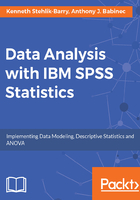
上QQ阅读APP看书,第一时间看更新
Variable properties - measure
In the Variable View, use the Measure cell to specify the level of measurement for the variable. Click in the Measure cell to activate a drop-bar list with three elements and select one:
- Scale: Data where the data values are intrinsically meaningful numbers reflecting order and distance. Examples are age in years, temperature in Fahrenheit units, and education as the highest grade completed.
- Ordinal: Categorical data where there is a rank order of categories. Ordinal data can come about through grouping of scale values into broad groups, for example, age groups obtained through binning of ages. In addition, Likert-type items with responses such as Very Satisfied, Somewhat Satisfied, Neither Satisfied Nor Dissatisfied, Somewhat Dissatisfied, and Very Dissatisfied are ordinal in measurement.
- Nominal: Categorical data where the categories are unordered. Examples are marital status and postal code area.
Procedures such as Codebook, Tables, and Chart Builder recognize the measurement-level definitions and produce different statistics or charts for different measurement types, so make sure that you specify the correct Measure level for each variable.
The equivalent syntax is the VARIABLE LEVEL command.